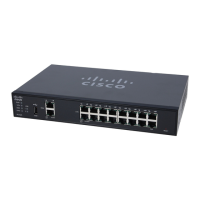To configure WAN Queuing, follow these steps:
Step 1
Click QoS > WAN Queuing.
Step 2
Above the WAN Queuing Table, select the desired Queuing Engine (Priority, Rate-control, or Low-latency).
Step 3
In the WAN Queuing Table, click Add and enter a name for the policy and provide a description.
Step 4
If Priority Queuing was selected, in the Queuing Priority Table, select the Traffic Class for each queue from the drop-down
list.
Step 5
If Rate Control Queuing was selected, in the Queuing Rate-Control Table, select the Traffic Class and enter the Minimum
and Maximum Rate for each queue.
Step 6
If Low-latency Queuing was selected, in the Queuing Low-Latency Table, select the Traffic Class and configure the
bandwidth share value for each queue.
Step 7
Click Apply.
WAN Policing
In WAN Policing, the rate-control mode supports eight queues. Each queue can be configured with a maximum
rate.
To configure the WAN Policing page, follow these steps:
Step 1
Click QoS > WAN Policing.
Step 2
Check Enable policing of traffic on WAN interfaces.
Step 3
In the Policy Class Table, configure the following for each queue:
Select Unspecified or Default.Traffic class
Enter the queue’s maximum rate of bandwidth in percentages to limit the incoming
traffic from WAN to LAN.
Maximum Rate
Step 4
Click Apply.
WAN Bandwidth Management
WAN interfaces can be configured with the maximum bandwidth provided by the ISP. When the value (transfer
rate in KBP/S) is configured, the traffic entering the interface is shaped in defined rate.
RV345/345P Administration Guide
49
QoS
WAN Policing

